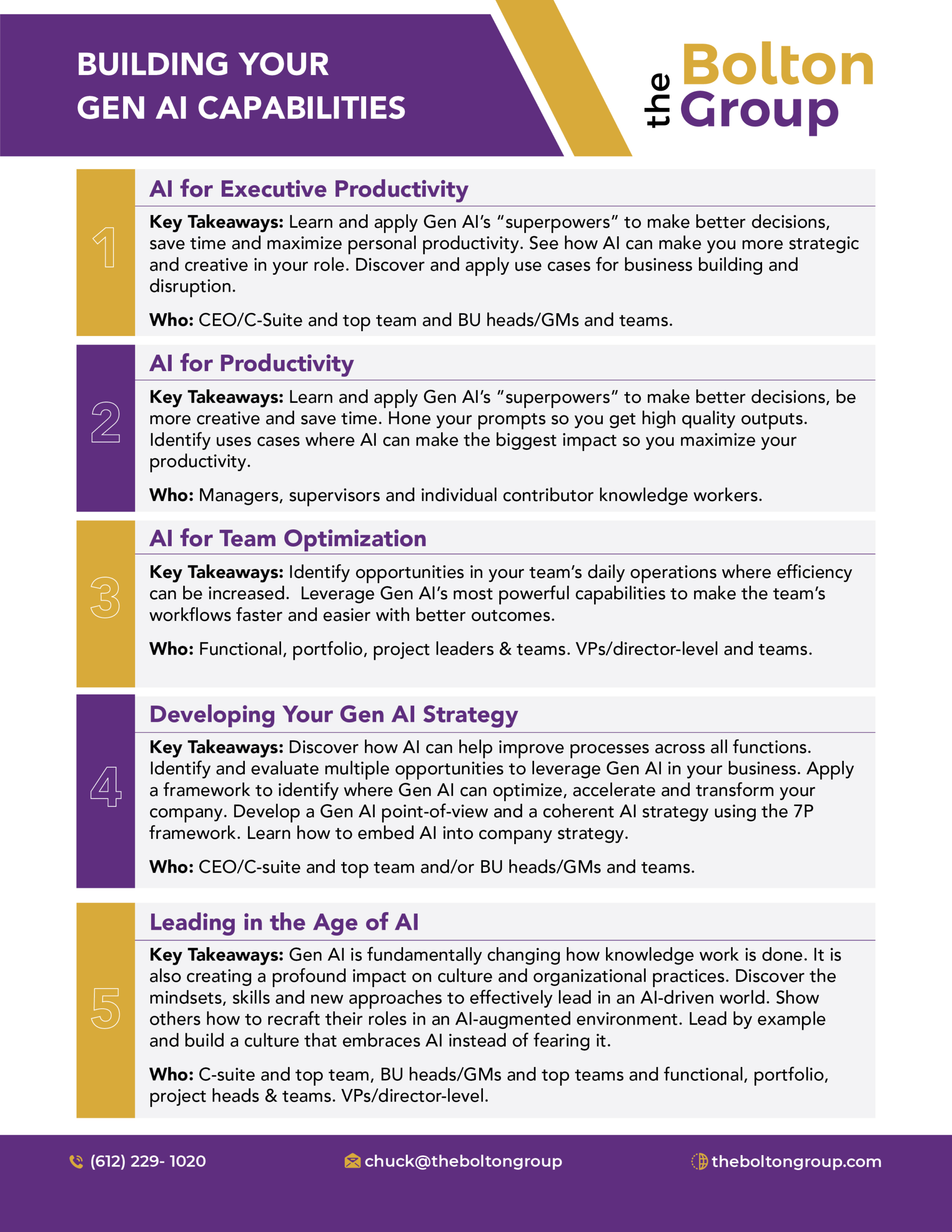As a leader, it’s your job to get results, to create value and impact in a sustainable way. Your job is to inspire your followers by your example. To get everyone aligned. To help each person become their best. Do these things and you are a value creator. You create great impact. Fail to do these things and you are a value destroyer.
As a leader, are you performing like this? Are you a value creator or a value destroyer?
Consider these statistics about the state of leadership today:
- Fewer than 20% of leaders have a strong sense of their own individual purpose.[i]
- Only 49% agreed they get to use their strengths to do what they do best every day.[ii]
- 58% of workers trust strangers more than their own boss.[iii]
- 60% of workers have left a job or would leave a job over a bad boss.[iv]
- 65% of workers say they’d take a new boss over a pay raise.[v]
- 70% of employees are disengaged at work.[vi]
- 75% say their bad boss is the worst part of their workplace.[vii]
- 79% don’t feel appreciated by the boss.[viii]
- 83% of US workers suffer from work-related stress. The main source of stress at work is their boss.[ix]
These are damning findings about the state of leadership. These shared perceptions point to a leadership crisis. If you are a leader, the odds are you’ve got a problem. Flip these statements around and try them on yourself? What would your people say about you?
To compound the leadership effectiveness problem, there is a leadership shortage. With baby boomers retiring and leaving the workforce, companies are worried about the readiness of other leaders to succeed the departing ones.
In the 2019 Global Human Capital Trends report, Deloitte reported: “Eighty percent of executives rate leadership as a high priority for their organizations. But only forty-one percent think their organizations are ready to meet their leadership requirements.”[x] A leadership crisis combined with a leadership shortage is a disaster. But it is also an opportunity for you, if you are committed to becoming the best leader you can be and creating great impact.
How’s your self-awareness? Most leaders are unaware of how they impact others. Seventy-five percent of leaders think they are in the top ten percent of leadership. That’s statistically impossible. The bottom fifty percent of the class at Harvard Medical School couldn’t be in the top ten percent of their profession either. For leaders, this means sixty-five percent are delusional. When was the last time you completed a 360-degree feedback assessment of yourself?
You may have been a leader for many years. You may be smart with a high IQ. You may have considerable expertise and experience in your industry. You may have an MBA from a top-tier school. You may point to your track record of promotions and results and believe you’ve been successful. Perhaps. Those are the hallmarks of twentieth century success. What made you successful in the past is no assurance you’ll be successful in the future, if you don’t reinvent. The rules for leading have changed.
Would your followers say you don’t have a sense of your individual purpose? Do your team members trust strangers more than you? Do they feel unappreciated? Are they disengaged? Do they suffer from stress you have induced?
If you answered “yes’ to any of the questions above, you are failing as a leader. Any question that you have answered “yes” is due to the way people are treated by you and the environment you create.
Where do you stand?
As the leader, you’ve been given a gift. The gift of leadership is a privilege. When you lead others, and do it well, it is the most noble of professions. It’s a responsibility and an opportunity. There is no other occupation where you can help so many others learn and grow. It provides you, as the leader, the opportunity and the responsibility for making an indelible contribution to the lives of your followers. As a bonus, you get to be recognized for your team’s achievements and impact when you succeed.
To thrive and flourish in these times, in today’s hypercompetitive, volatile and uncertain world, where virtually every company is reinventing its business model and the way it operates due to technological disruptions, relentless competition, shifting demographics, and generational preferences, you have to reinvent yourself. Unfortunately, few leaders are reinventing themselves. If you aren’t reinventing yourself, learning and growing continuously, you’ve got a problem. Your career, your earnings, your dreams—they are all at risk.
“Save yourself, and you will save a thousand around you.”
Saint Seraphim of Sarov
To reinvent as a leader is to consciously transform how you operate, connect, and lead so you can stay relevant and energized, capable of creating maximum value.
The question is, how do you do this?
You start by serving your people extraordinarily well. To help them be successful at work and in their lives.
Here are the new rules of leadership:
- Your #1 Role is to Lead by Example
You dictate all behavior, not by your orders or mandates, but by your example.
Why is this so important? Because people learn by mimicking. It’s a “monkey see, monkey do” world. As the leader, everyone is always looking at you. You are always on stage. People don’t go as fast as they can. They only go as fast you, the leader. Your speed determines the speed of your pack. That is why you have to be excellent in everything you do.
As the leader, you have to be the most positive, the most purposeful, the most passionate, the most productive, and the most impactful. You need to be the most disciplined, the most consistent, the most authentic, the most service-driven, the most committed to learning, the most committed to growth, and the most committed to reinvention.
Think about Usain Bolt, who won the gold medal and set the world record in the 100 meters in the 2012 London Olympics. He ran the 100 meters in only 9.63 seconds. Not only did Bolt set the record, but the silver and bronze medalists both finished the race under 9.8 seconds, the first time in history for the top three finishers. When Yohan Blake and Justin Gatlin, the silver and bronze medalists, were asked how they ran so fast, they answered, “Trying to catch Usain.” Bolt didn’t just win the 100 meters in 2012. He won gold in the 100 meters and 200 meters in 2008, 2012 and 2016. He is the only sprinter in history to have ever done so.[xi]
The speed of Usain Bolt—the leader—determined the speed of the pack. He set the pace, the standard, for the competition. He raised everyone’s games. His competitors ran faster because of him. As the leader of your group, you have to do the same.
Do you hold yourself to the highest standard, like Usain Bolt did in the sprints? Do you expect excellence of yourself? You must hold yourself to the highest standard first before you can hold your team members accountable for excellence.
When you fly on a plane, the flight attendant in her pre-flight instructions reminds you that in case of an emergency, you must put the oxygen mask on your face first before helping others. The same is true for creating impact. You’ll need to gain clarity of your purpose, gifts, strengths, and passions first. You will need to recraft your role and turbocharge your productivity first so that you can create great value and impact. Then, show and coach others so they discover and excel, too.
People want to commit to a purpose, to people, profit, and the planet. People want to be inspired. Leaders who operate with purpose, passion, and productivity are a company’s force multiplier. They are the untapped source of value for most companies because only a few leaders are operating to create value and impact. Most are managing for output and maybe engagement.
Are you leading like the leader you would want to follow? Where do you need to improve, learn, grow, and reinvent? What commitments have you made to become your best and create great impact?
- Reinvent Yourself
To reinvent yourself as a leader, start by creating and articulating your individual purpose, your values and then living them with integrity.
Show your people how to connect their purpose with the collective purpose of your business. They likely don’t know their gifts (what others perceive) and talents. They may not know what they’re blessed with. Help them discover their purpose, gifts, and talents. They’ve likely lost touch with their passions. How about helping them find their passions?
Leaders with purpose who communicate this purpose to their followers inspire their people to be[xii]:
- 8 times more likely to stay at the company;
- 2 times more likely to have higher job satisfaction; and
- 70% more satisfied with their jobs.
Virtually everyone wants purpose and meaning in their work and life.
DeVry U Career Advisory Board studied millennials’ attitudes regarding their work. They found that seventy-one percent of millennials ranked finding meaningful work as one of the top three key elements they used to evaluate their success. Thirty percent reported it as the single most important element. It was also reported that they were willing to sacrifice more traditional career comforts in pursuit of more meaningful work.[xiii]
Once people have a sense of their individual purpose, how about helping them express their purpose through their work and showing them how to identify and apply their passions and energy? As purpose is defined and they get more passionate about their work, how about showing them how to be more productive using the OKR productivity system to get more done with less effort? So they can create greater value.
People who aren’t purposeful, passionate, and productive simply don’t increase their value or their company’s value.
Need more proof? Deloitte Insights reported that “purpose-driven” companies tend to have thirty percent higher productivity and forty percent higher levels of retention.
- Get Everyone Aligned
The leader makes the difference between success and failure as to whether the team, company, or country succeeds or fails. As the leader, you are the one who can draw out extraordinary efforts of people or you can be the cause of your team’s downfall. High performance is only made possible through alignment—it’s your job. A talented team of people that lacks alignment and focus loses.
As work becomes increasingly digitized and information is ubiquitous, the role of managers and leaders as coordinators of work has largely disappeared. The challenge now is creating alignment as you are leading virtual teams, working under flexible arrangements, managing multi-generational and diverse groups, and supporting the flow of knowledge.
How do you align? You get alignment by everyone understanding the vision, purpose, and values of the company. Everyone must understand how their role contributes to the greater purpose of the company. Get everyone on the same page about the Objectives and Key Results to be achieved, and also how their OKRs support the company. Communicate how decisions are made and who has decision rights. Help your team members understand the impact their contributions have on the company. This will foster a feeling of purpose, belonging, and connectedness. Practice transparency. That’s what alignment is all about.
Few employees are adding the value they are capable of creating. It’s your job to help them contribute more, to add more value, and to become better versions of themselves.
- Help People Become Their Best
When you encourage your people to define and communicate their purposes, ignite their passions, and turbocharge their productivity, you are on your way. Help them grow professionally and personally. Understand and help them achieve their dreams.
Matthew Kelly, author of The Dream Manager, writes, “If you want employees to contribute heart and mind to the enterprise, then you must commit heart and mind to helping them achieve their dreams—to develop as persons who not only serve today’s customer with verve but are in a position to move on and move forward in the crazy-getting-crazier world in which they are imbedded.”[xiv]
“The key to creating an ownership culture is getting to people’s hearts. You have to get to people’s pride.”
Joe Kaeser, CEO, Siemens
Tom Peters writes in his brilliant book, The Excellence Dividend: Meeting the Tech Tide with Work that Works and Jobs that Last, about the importance of a leader helping others become their best versions of themselves. He shares his Corporate Mandate 2018: “Your principal moral obligation as a leader is to develop the skill set of every one of the people in your charge (temporary as well as semi-permanent) to the maximum extent of your abilities and in ways that are consistent with their ‘revolutionary’ needs in the years ahead. The bonus: This is also the #1 profit maximization strategy!”[xv]
Is that your principal moral obligation as a leader?
Here are two questions for you to consider:
Does everyone who works under you grow as people?
While working under you, do they become better, wiser, more purposeful, passionate, more energetic, more productive, and better able to create greater impact?
A powerful way to connect with and coach your followers is to implement a regular meeting to build individual responsibility, the W-5 (Work in 5 directions) meeting. A W-5 session offers a powerful opportunity to promote self-accountability and professional development. The five directions of work are: customer, direct reports, peers, manager, and self-development.
When you hold these sessions every week – or at least – every other week, in the right spirit, you’ll hold your team members accountable only when they don’t hold themselves accountable. The goals of these meetings are to develop your team members, help them learn and grow, commit to constant improvement and commit to achieving maximum impact.[xvi]
The purpose of this forty-five minute meeting is to discuss the team member’s OKR performance, and how she’s growing and learning. It is the team member’s responsibility to schedule and lead the meeting. She explains how she is meeting and exceeding the requirements in each of the five directions, and a plan to correct any deficiencies. She brings up specific co-workers with whom she frequently interacts, the quality of the interaction, and the strength of the working relationship. She covers successes and failures, shortcomings and accomplishments.
The two of you identify specific areas in which you can assist. The spirit is open and non-judgmental, and the coaching is honest and collaborative. Look for ways to encourage, support, and recognize her. After the team member nears the end of the discussion with you, ask how you can help her achieve results—support her. Ask questions such as the following:
- What are you working on? How are your OKRs coming along?
- What’s getting in your way?
- What are the roadblocks you face?
- How can I best help you be more successful?
- How are you growing and developing to achieve your career goals?
“Three things every human being wants most: to be seen, heard, and understood.”
Oprah Winfrey
Think team members don’t want W-5 sessions? According to PwC, 60% of employees—and 72% of millennial employees—desire feedback daily or weekly. A study conducted by Adobe showed that 80% of office workers want immediate, in-the-moment feedback.[xvii]
A Workhuman 2019 global employee survey, “The Future of Work is Human,” revealed that team members who check in with their manager at least weekly are more than twice as likely to trust their manager.[xviii] W-5s are the linchpin of continuous performance management, the leader’s moment for rich conversation, feedback, and recognition.
In addition to promoting self-accountability and strengthening alignment, the W-5 meeting gives you as a leader, a power platform for recognizing and energizing your people. Perhaps no human need is more neglected in the workplace than feeling valued. The need for significance in work is a manifestation of our inborn hunger for meaning in our lives. People have a genuine hunger to be recognized, respected, and genuinely cared about. That’s your job, leader. As they operate by purpose and perform, remember what people really want. To feel good and validated. There are two things people can’t give themselves: personal attention and appreciation. The number one reason companies lose top talent is that they didn’t feel appreciated.
“The only thing more powerful than sex and money is praise and recognition.”
Mary Kay Ash
As the leader, are your recognizing and appreciating your people sufficiently?
Twenty-five percent? Or one hundred percent? Think about each of your team members. Most of them can probably “meet expectations” with two hands tied behind their back. They can easily perform ordinary, satisfactory work. That takes maybe 25% of their effort.
What about the other 75%? Are you getting the other 75% of their capability, too?
Getting the other 75% is voluntary and is entirely based on you. It’s based on how well you inspire them. How do you get the other 75%? Give them a challenge. Invite them to operate with purpose to create a great impact and to tackle huge dreams. Coach, praise and recognize them.
Whose List Will You Be On?
One last thought, when the people who have worked under you put their list of “Best Bosses” together, who’s list will you be on? What is your legacy in the collective minds of your followers – both current and past? Is that legacy what you’d like it to be? Would they say you are among the best leaders they ever worked for? Did you help them learn, grow, and become their best as people? Did you help them live better lives? Did you touch their lives indelibly?
Reinvent yourself, leader. Lead by example. Get all aligned. Help others become the best versions of themselves. Do this and you’ll be a massive value creator. You’ll create great impact.
From Appendix 2 of Reinvent Your Impact: Unleashing Purpose, Passion and Productivity to Thrive

[i] “From Purpose to Impact, Nick Scott and Scott Snook,” Harvard Business Review, May 2014,
https://hbr.org/2014/05/from-purpose-to-impact.
[ii] Only 49% agreed…, “2019 Human Capital Trends Study,” Deloitte Insights, 2019,
https://www2.deloitte.com/content/dam/Deloitte/cz/Documents/human-capital/cz-hc-trends-reinvent-with-human-focus.pdf.
[iii] “Workplace Trust – 58% Trust Strangers More Than Their Own Boss,”
https://www.onemodel.co/blog/workplace-trust.
[iv] “Your best employees are leaving,” Randstad USA, August 28, 2018
https://rlc.randstadusa.com/press-room/press-releases/your-best-employees-are-leaving-but-is-it-personal-or-practical.
[v] “65% of workers say they’d take a new boss over a pay raise,” Ty Kiisel, Forbes, https://www.forbes.com/sites/tykiisel/2012/10/16/65-of-americans-choose-a-better-boss-over-a-raise-heres-why/#3afbe44176d2.
[vi] “70% of employees say they are disengaged at work. Here’s how to motivate them,” World Economic Forum, November 4, 2016,
https://www.weforum.org/agenda/2016/11/70-of-employees-say-they-are-disengaged-at-work-heres-how-to-motivate-them/.
[vii] 75% say their bad boss is the worst part of their workplace, “8 Unsettling Facts About Bad Bosses,” HuffPost, December 6, 2017,
https://www.huffpost.com/entry/8-unsettling-facts-about-_b_6219958.
[viii] “79 Percent of Employees Quit Because They Are Not Appreciated,” Todd Nordstrom, Inc., September 19, 2017,
https://www.inc.com/todd-nordstrom/79-percent-of-employees-quit-because-theyre-not-ap.html.
[ix] “42 Worrying Workplace Stress Statistics,” The American Institute of Stress, September 25, 2019,
https://www.stress.org/42-worrying-workplace-stress-statistics.
[x] “Leading the social enterprise: Reinvent with a human focus,” “2019 Human Capital Trends Study,” Deloitte Insights, 2019,
https://www2.deloitte.com/content/dam/Deloitte/cz/Documents/human-capital/cz-hc-trends-reinvent-with-human-focus.pdf.
[xi] “Athletics at the 2012 Summer Olympics – Men’s 100 meters,” Wikipedia,
https://en.wikipedia.org/wiki/Athletics_at_the_2012_Summer_Olympics_–_Men%27s_100_metres.
[xii] “Leaders with purpose who communicate this purpose to their followers…” The Human Era @Work: Findings from the Energy Project and Harvard Business Review, 2014,
https://uli.org/wp-content/uploads/ULI-Documents/The-Human-Era-at-Work.pdf.
[xiii] How the Recession Shaped Millennial and Hiring Manager Attitudes About Millennials’ Future Careers, Career Advisory Board, DeVry University, 2011,
https://www.careeradvisoryboard.org/content/dam/dvu/www_careeradvisoryboard_org/Future-of-Millennial-Careers-Report.pdf.
[xiv] The Dream Machine, Matthew Kelly, Hachette Book Group.
[xv] The Excellence Dividend: Meeting the Tech Tide with Work that Works and Jobs that Last, Tom Peters, Random House.
[xvi] “Torpedo Annual Reviews Try W-5 Instead,” Chuck Bolton, Upsize Magazine,
http://www.upsizemag.com/business-builders/torpedo-yearly-reviews.
[xvii] “5 Employee Stats You Need to See,” Maren Hogan, February 2016,
https://business.linkedin.com/talent-solutions/blog/trends-and-research/2016/5-Employee-Feedback-Stats-That-You-Need-to-See.
[xviii] The Future of Work is Human: Findings from the Workhuman Analytics & Research Institute Survey, 2019,
https://www.workhuman.com/press-releases/White_Paper_The_Future_of_Work_is_Human.pdf.























